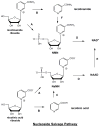NAD(+) metabolism: Bioenergetics, signaling and manipulation for therapy
- PMID: 27374990
- PMCID: PMC5521000
- DOI: 10.1016/j.bbapap.2016.06.014
NAD(+) metabolism: Bioenergetics, signaling and manipulation for therapy
Abstract
We survey the historical development of scientific knowledge surrounding Vitamin B3, and describe the active metabolite forms of Vitamin B3, the pyridine dinucleotides NAD+ and NADP+ which are essential to cellular processes of energy metabolism, cell protection and biosynthesis. The study of NAD+ has become reinvigorated by new understandings that dynamics within NAD+ metabolism trigger major signaling processes coupled to effectors (sirtuins, PARPs, and CD38) that reprogram cellular metabolism using NAD+ as an effector substrate. Cellular adaptations include stimulation of mitochondrial biogenesis, a process fundamental to adjusting cellular and tissue physiology to reduced nutrient availability and/or increased energy demand. Several mammalian metabolic pathways converge to NAD+, including tryptophan-derived de novo pathways, nicotinamide salvage pathways, nicotinic acid salvage and nucleoside salvage pathways incorporating nicotinamide riboside and nicotinic acid riboside. Key discoveries highlight a therapeutic potential for targeting NAD+ biosynthetic pathways for treatment of human diseases. A recent emergence of understanding that NAD+ homeostasis is vulnerable to aging and disease processes has stimulated testing to determine if replenishment or augmentation of cellular or tissue NAD+ can have ameliorative effects on aging or disease phenotypes. This experimental approach has provided several proofs of concept successes demonstrating that replenishment or augmentation of NAD+ concentrations can provide ameliorative or curative benefits. Thus NAD+ metabolic pathways can provide key biomarkers and parameters for assessing and modulating organism health.
Keywords: NADH; Nicotinamide adenine dinucleotide; Nicotinamide riboside; Nicotinic acid riboside; Tryptophan; Vitamin B3.
Copyright © 2016. Published by Elsevier B.V.
Figures






References
-
- Rajakumar K. Pellagra in the United States: A Historical Perspective. Southern Medical Journal. 2000;93 - PubMed
-
- Hegyi J, Schwartz RA, Hegyi V. Pellagra: dermatitis, dementia, and diarrhea. International journal of dermatology. 2004;43:1–5. - PubMed
-
- Sydenstricker VP. The history of pellagra, its recognition as a disorder of nutrition and its conquest. The American journal of clinical nutrition. 1958;6:409–414. - PubMed
-
- Goldberger J. The Etiology of Pellagra: The Significance of Certain Epidemiological Observations with Respect Thereto. Public Health Reports (1896–1970) 1914;29:1683–1686.
Publication types
MeSH terms
Substances
Grants and funding
LinkOut - more resources
Full Text Sources
Other Literature Sources
Medical
Research Materials

